Carden Alvar Natural Area
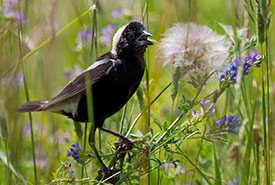
Bobolink, Prairie Smoke Nature Reserve, Carden Alvar, ON (Photo by NCC)
Why this place is important
Located northeast of Lake Simcoe, the Carden Alvar supports some of the highest quality and most extensive alvar habitat on the planet within a mosaic of grassland, wetland and forest. Lying at the crossroads of northern and southern Ontario, Carden Alvar is home to a variety of species — including some more common on the Canadian Shield — such as moose and black bear. The natural area has also been designated as an Important Bird and Biodiversity Area, an Area of Natural and Scientific Interest and contains globally rare alvar habitat and species.
Carden Alvar is recognized worldwide as a destination for birdwatching due to the large number and diversity of grassland birds, incuding grasshopper sparrow, bobolink, upland sandpiper, field sparrow, eastern meadowlark and eastern loggerhead shrike.
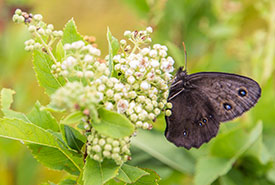
Butterfly count, Carden Alvar, ON (Photo by NCC)
Alvars are naturally open habitats with either a thin covering of soil or no soil over a base of limestone or dolostone. Their unique geologic and physical characteristics set the stage for natural communities that simply cannot exist elsewhere. Alvars are rare; they are found in only a handful of locations across the globe, including the eastern European Baltic region, the United Kingdom and Ireland. In North America, almost 75 per cent of alvars are located in Ontario.
Carden Alvar is one of the largest and most significant collections of alvars in the world. The 17,230-hectare (42,576-acre) Carden Alvar Natural Area, which contains a mixture of alvar, forest, wetland and grassland, is located in the central portion of the Eastern Great Lakes Lowland Forests region, which spans from the central shores of Lake Huron in Ontario across the north shore of Lake Ontario and along the St. Lawrence River corridor into Quebec and northern New York State.
What NCC is doing
Due to its importance and the threats it faces, the Carden Alvar Natural Area has been the focus of the Nature Conservancy of Canada’s (NCC’s) conservation efforts since 1998. NCC and our partners have helped protect over 3,642 hectares (9,000 acres) of this internationally important area.
Keeping the alvar free from the encroachment of woody species (bushes and small trees) is one of NCC’s priorities. Historically, these areas were kept open thanks to wildfires and other natural disturbances, but when natural fire is suppressed both native and invasive species colonize these open habitats. NCC and other conservation partners have stepped in to give the area a helping hand.
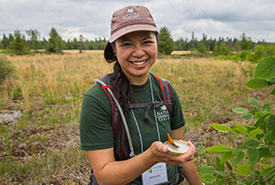
Jenna Siu, butterfly count, Carden Alvar, ON (Photo by NCC)
Each year, NCC, our partners and our volunteers remove invasive and woody species through cutting and prescribed burns. NCC is interested in exploring grazing as another conservation tool for our properties. We recognize the value in partnering with local cattle farmers as a way to successfully manage grassland habitats for birds, which is something NCC has been successful in implementing elsewhere in the province. Cattle help keep down the unwanted vegetation, and natural areas become working landscapes that help the local community.
Managing and encouraging ecotourism is also an important goal for NCC. In 2018, North Bear Alvar in the Carden Alvar Natural Area became a Nature Destination. With both physical trails on the North Bear Alvar property and a virtual 360-degree tour through Google Maps of a nearby nature trail, visitors and locals can enjoy this unique ecosystem and the species that live there.
What lives there
These are some of the significant and at-risk species found in this natural area:
Reptiles, amphibians and turtles
Take a virtual tour of the Carden Alvar.
- Blanding's turtle - Great Lakes / St. Lawrence population (endangered)
- eastern ribbonsnake - Great Lakes population (special concern)
- snapping turtle (special concern)
- midland painted turtle (special concern)
- western chorus frog - Great Lakes - St. Lawrence - Canadian Shield population (threatened)
Birds
- bank swallow (threatened)
- barn swallow (threatened)
- bobolink (threatened)
- common nighthawk (special concern)
- eastern loggerhead shrike (endangered)
- eastern meadowlark (threatened)
- eastern whip-poor-will (threatened)
- eastern wood-pewee (special concern)
- golden-winged warbler(threatened)
- grasshopper sparrow - pratensis subspecies (special concern)
- wood thrush (threatened)
- yellow rail (special concern)
Current Projects Click here to learn more about our current projects in the Carden Alvar Natural Area.
Insects
- monarch (endangered)
Plants
- black ash (threatened)
- butternut (endangered)
- round-stem false foxglove (endangered)
- small white lady's-slipper (threatened)
Threats
Habitat loss, fragmentation, development and pollution have all put the Carden Alvar at risk. Its proximity to the Greater Toronto Area and cottage country make it an ideal location for recreation, and its limestone is attractive for gravel operations. NCC is committed to working with the community to find a balance between competing land interests, ensuring that this unique ecosystem can thrive into the future while the local community and various interest groups can prosper as well.
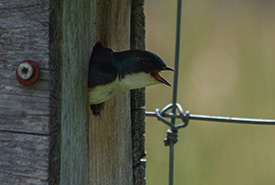
Tree swallow, Prairie Smoke Nature Reserve, Carden Alvar, ON (Photo by NCC)
Like so many other natural areas across the province, invasive species continue to be a primary threat here. Each year staff and volunteers spend hundreds of hours in the blazing sun and pouring rain removing dog-strangling vine, buckthorn, tartarian and Morrow’s honeysuckle, phragmites and common frogbit from the alvars, wetlands and forests of Carden Alvar.
History
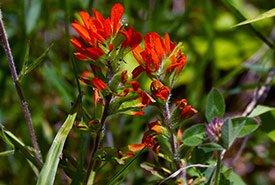
Painted cup, North Bear Alvar, Carden Alvar, ON (Photo by NCC)
The Carden Alvar area has a strong agricultural tradition. Its open areas have been instrumental in its success as a local beef cattle ranching hub.
NCC has worked in the Carden Alvar area since the acquisition of the Katherine McCuaig MacDonald Nature Reserve in 1998. In the mid-2000s, NCC purchased the large Cameron Ranch and Windmill Ranch properties in the heart of the Carden Alvar, working closely with the Couchiching Conservancy and Ontario Parks/Ministry of Natural Resources and Forestry. Today, those three pieces make up the Carden Alvar Provincial Park, owned and managed by Ontario Parks. These three partners, and other local groups and individuals, have continued to work closely on additional acquisition and on-going stewardship.
Come visit us
Experience the unique sights, scents and sounds of Carden’s alvars and wetlands. Alvars are globally rare ecosystems characterized by shallow soils on limestone bedrock. Meander along a boardwalk through a wet meadow. Listen to the music of grassland birds and insects while wandering through a field of flowers and enjoying the peace of nature.
The North Bear Alvar is a mix of extensive grassland, shrub and treed alvars that support unique species. Logs and rocks provide cover for snakes, and wetlands are home to many frogs and turtles. Keep an eye out — you might even spot a moose or black bear!
Learn more about the North Bear Alvar Nature Destination.
Partners
The protection of the Carden Alvar is not something we can achieve on our own. Only through strong partnerships can this unique area continue to grow and thrive. NCC would like to thank the following partners for their generous support of our ongoing efforts in this natural area:
- Couchiching Conservancy
- Ontario Parks
- Carden Field Naturalists
- Local landowners, property stewards and community members
- Wildlife Preservation Canada
- Toronto Ornithological Club
- Ontario Field Ornithologists
Current Projects
Click here to learn more about our current projects in the Carden Alvar Natural Area.
For more information on this natural area, you can read the Carden Alvar Natural Area Conservation Plan Executive Summary.
Please consider a gift to help portect and care for the Carden Alvar Natural Area.






